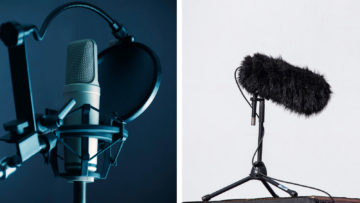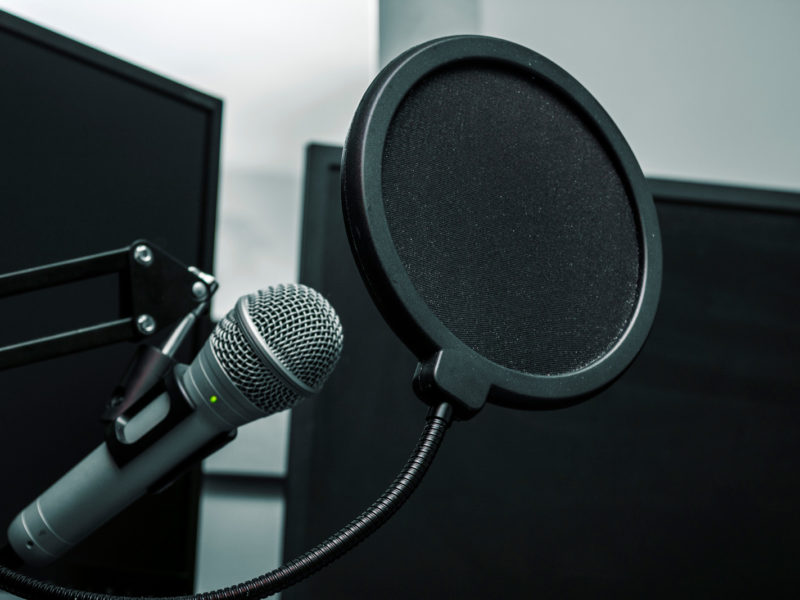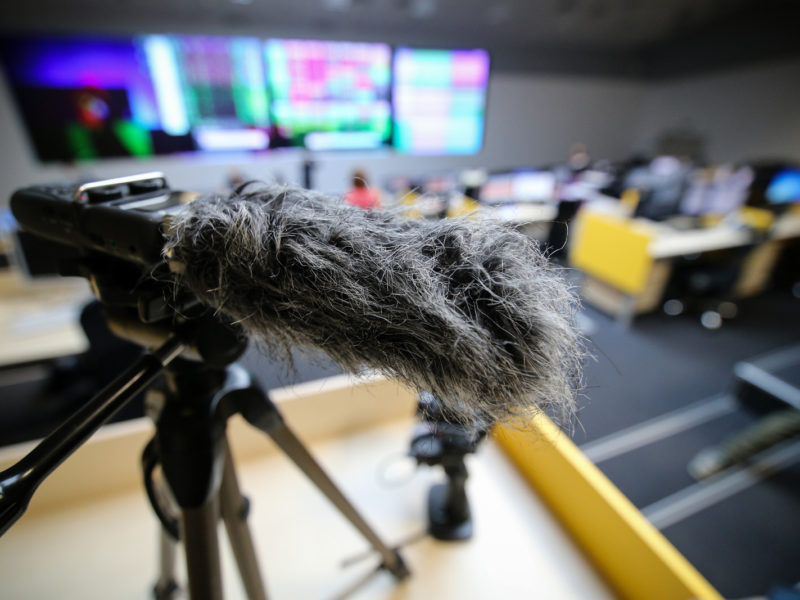How to Charge AirPods Without a Case
Discover the truth about how to charge AirPods without a case. Uncover myths, find alternatives, and safeguard your audio experience.

Countless performers and recording artists have been pictured using pop filters and windscreens in conjunction with their microphones. Both pop filters and windscreens are effective tools in reducing unwanted noise to add to your recording studio equipment list. However, the types of annoying sounds they suppress are different. Additionally, the environments in which they are utilized vary in a big way.
While recording, a pop filter sits in front of a microphone and is used to filter out harsh vocal sounds where a windscreen completely covers a microphone and is generally used to filter out unnecessary background noises like wind and air conditioning.

Microphone with a pop filter
Most of us have seen pictures of our favorite artists wearing professional studio headphones while recording vocals in front of a pop filter positioned between their microphones and themselves.
Popping sounds, while not necessarily a problem in normal conversation or purely acoustic music settings, are extremely annoying when recorded. The sounds themselves center around what are called “plosives”. The first “p” in the word “popular” would be considered a plosive. Words beginning with ‘t’, ‘k’, ‘d’, ‘b’, and ‘g’ are also problematic. All of these hard consonant sounds can cause a burst of fast moving air which have an actual mechanical impact on a microphone element. That impact creates the dreaded pop sound.
Physically, the pop filter looks like a small screen (if you have a screen door, picture about a 6 inch circle cut out of it) suspended on a mounting arm. The material used in the filter varies, but is usually a very tightly stretched nylon fabric or, in some cases, a metal screen. The mounting arm is typically connected to the mic stand and is flexible so it can be moved into an appropriate position between the vocalist and microphone.
The pop filter’s screen has acoustic properties which essentially mute popping sounds’ unwanted frequencies while letting all other “good” frequencies through.The use of pop filters is an accepted standard in recording studios around the world.
For more information on how a pop filter might fit into your recording environment, check this out:
Absolutely not! They work to suppress these same unwanted sounds for spoken word broadcast sources. Podcasters can especially benefit from using a pop filter to clean up their sound and it’s one of the more necessary items in any recording studio starter package.

Microphone with windscreen
Windscreens are another device widely used to suppress unwanted sounds. However, windscreens have their own unique characteristics which may make them the preferred option in certain settings. The windscreen’s filtering capabilities are different from the pop filter.
The windscreen is physically different compared to the pop filter. A windscreen is typically made out of a foam type material, though you might also see some made out of what looks like fur. Instead of having a mounting arm, the windscreen is basically just in the form of a sleeve that slides onto the microphone covering its capsule.
Windscreens excel at filtering out unwanted background noise. Among these is wind experienced at outdoor live music venues. Wind blowing across a microphone element creates an unpleasant “whooshing” sound that gets amplified through a sound system. It’s a sound that can greatly distract listeners from an artist’s performance. Additionally, if the “whooshing” is extreme, it can create feedback problems which represent the ultimate buzzkill for both performers and listeners of live music.
No. Some singers have a very natural “breathiness” to their voices. While a little of that breathiness may enhance a vocal performance, too much of it can be annoying. A windscreen’s filtering capabilities make them effective tools in combating basically any unwanted background noise.
Windscreens can potentially cut out some high frequencies. In most cases, that’s not a problem, but depending on the sound source (think mic’ing of high hat cymbals, etc.,) the windscreen might keep that source from cutting through the mix effectively. Windscreens are especially effective when used with omnidirectional mics. Cardioid mics are naturally more resistant to background noise due to their tighter dispersion patterns. However, omnidirectional mics can take in background noise from all directions, including the audience out front.
Here’s a good discussion about the merits of windscreens.
Many people who have a recording studio setup also dabble in live sound which means it’s pretty common to need both. Additionally, as a pop filter and windscreen filter unwanted noise in a different fashion, you may want to use them in conjunction with each other. Using them together could be just what is needed to tame a “difficult to record” vocalist! And, as both of these useful tools are relatively inexpensive, it just makes sense to be prepared for whatever noise issues crop up!
Pop filters and windscreens are both effective unwanted noise suppressors. The question of whether you need both lies squarely in your own personal application but they’re great to have on hand, especially considering they will be one of the most minor parts of the cost of a home studio.